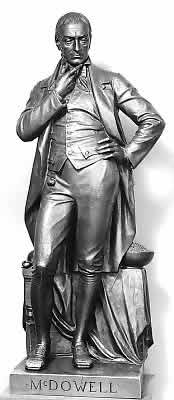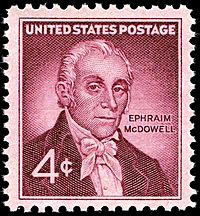Ephraim McDowell facts for kids
Quick facts for kids
Ephraim McDowell
|
|
|---|---|
 |
|
| Born | November 11, 1771 |
| Died | June 25, 1830 (aged 58) Danville, Kentucky, U.S.
|
| Occupation |
|
| Known for | First successful ovariotomy |
Ephraim McDowell (born November 11, 1771 – died June 25, 1830) was an American doctor and a very important surgeon. He was the first person to successfully remove a tumor from a woman's ovary. Because of this amazing achievement, he is often called "the father of ovariotomy." He is also known as a founder of abdominal surgery, which is surgery inside the belly.
Contents
Early Life and Education
Ephraim McDowell was born in Rockbridge County, Virginia. He was the ninth child of Samuel and Mary McDowell. His father, Samuel, was a soldier in the French and Indian War and a colonel during the American Revolution. In 1784, his family moved to Danville, Kentucky.
McDowell first studied at a special school called Worley and James. Then, he spent three years learning medicine from Dr. Alexander Humphreys in Staunton, Virginia. He also attended medical lectures in Edinburgh, Scotland, from 1793 to 1794. He studied with a surgeon named John Bell. Even though he didn't get a diploma at that time, the University of Maryland gave him an honorary medical degree in 1825.
A Pioneering Surgeon's Career
In 1795, McDowell returned from Scotland and started his medical practice in Danville, Kentucky. He became known for his surgical skills. He improved a technique called lithotomy, which is used to remove stones from the bladder. One of his famous patients was James K. Polk, who later became a U.S. President. McDowell removed a bladder stone and fixed a hernia for him.
The First Ovarian Surgery
On December 13, 1809, Dr. McDowell was called to see a patient named Jane Todd Crawford. She lived about 60 miles (97 km) from Danville. Other doctors thought Mrs. Crawford was pregnant, but Dr. McDowell realized she had a large tumor on her ovary. Mrs. Crawford was very sick and asked him to help her.
McDowell explained that no one had ever successfully removed such a tumor before. He told her that even the best surgeons thought it was impossible. Mrs. Crawford understood the risks but still wanted to go ahead with the operation. McDowell said he would do it if she would travel to his home in Danville. She agreed and rode the 60 miles (97 km) on horseback!
On Christmas morning, 1809, McDowell began the surgery. Back then, doctors didn't have anesthetic (medicine to make you sleep during surgery) or antisepsis (ways to keep germs out of wounds). The tumor McDowell removed weighed 22.5 pounds (10.2 kg). The whole operation took only 25 minutes.
Mrs. Crawford recovered very well. She went home 25 days after the surgery and lived for another 32 years! This was the first successful removal of an ovarian tumor in the world.
Before this time, almost all attempts at surgery inside the belly led to serious infections and death. People described McDowell as "neat and clean" and "meticulous." He was very careful. In his report, he wrote about removing blood and cleaning the area with warm water.
McDowell didn't publish details about his amazing surgery until 1817. By then, he had performed two more successful ovarian operations. He faced some criticism for waiting so long to share his discovery. However, records show he performed at least 12 such operations.
Personal Life and Community Role
In 1802, McDowell married Sarah Shelby. Her father was Isaac Shelby, a war hero and Kentucky's governor twice. Ephraim and Sarah had two sons and four daughters.
McDowell was an important person in his community. He helped start Centre College in Danville and was on its first board of trustees. In 1817, he became a member of the Philadelphia Medical Society. He was also the great-great-grandfather of General John Campbell Greenway.
McDowell was a Presbyterian, but he later became an Episcopalian. He even founded Trinity Episcopal Church in Danville, Kentucky, by donating the land for its first building.

Death and Legacy
In June 1830, McDowell became very ill with severe pain, nausea, and fever. He died on June 25, likely from appendicitis. His wife passed away 18 years later. They were first buried at Isaac Shelby's home, but in 1879, they were moved to a new burial spot near a monument built for him in Danville.
Honors and Recognition
- In 1879, the Medical Society of Kentucky put up a monument in his honor in Danville.
- In 1929, a bronze statue of McDowell was placed in the U.S. Capitol's National Statuary Hall Collection. This statue shows the ovarian tumor he removed. An identical statue is in the Kentucky State Capitol.
- On December 3, 1959, the U.S. Post office released a special 4-cent commemorative stamp honoring McDowell. This marked 150 years since his first successful ovarian operation.
- McDowell's house, office, and pharmacy in Danville are now a museum. It is recognized as a National Historic Landmark.
- The Ephraim McDowell Regional Medical Center in Danville is named after him.


